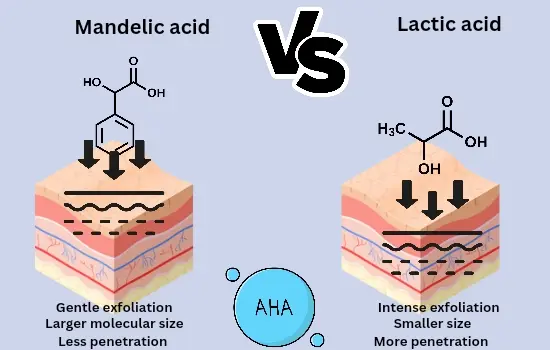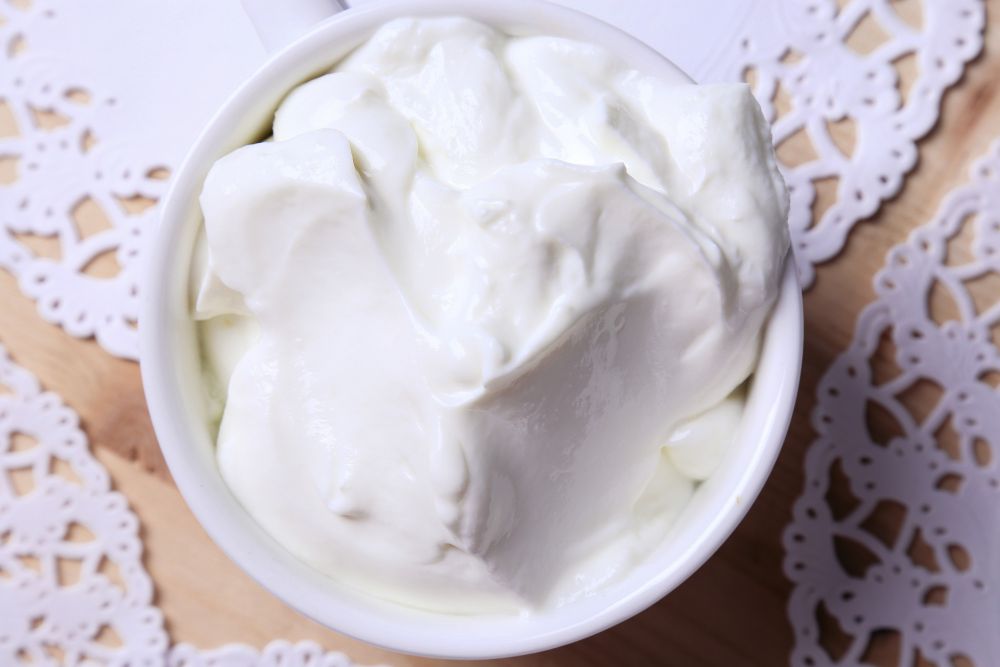The Ultimate Showdown: Mandelic Acid vs Lactic Acid- The Secret to Glowing Skin
Choosing the right skincare ingredient is the key to glowing and healthy skin. Mandelic and lactic are Alpha-hydroxy Acids, and both are beneficial in achieving a bright and smooth complexion. But which one is truly the holy grail for your skin? Let’s explore these individual ingredients that are suitable for you and how you can use each product in your skincare routine.
Mandelic acid vs Lactic acid:
To achieve radiant and flawless skin, the battle between skincare ingredients makes us wonder which one is beneficial to unlock the potential of the skin. There are two categories of skincare acids: Beta hydroxy acids and alpha hydroxy acids. Mandelic acid and lactic are two incredible alpha hydroxy acids. Both have remarkable benefits, and each has its distinct qualities.
Mandelic acid Offers gentle and effective exfoliation and targets acne breakouts, uneven skin texture, and fine lines. It is best suited for people with sensitive skin and dry skin. At the same time, Lactic acid has superb moisturizing properties. Moreover, it reduces hyperpigmentation and promotes a youthful glow.
Mandelic Acid:
In the world of skincare acids, mandelic acid can transform your skin health and complexion. Mandelic acid is derived from almonds. It is a gentle but potent AHA that has numerous benefits. It has a unique molecular structure that helps deep penetration. As a result, it exfoliates dead skin cells, unclogs pores, and reduces scars and hyperpigmentation. This powerhouse ingredient is suitable for all skin types. Moreover, it revitalizes your skin tone and texture and also stimulates collagen production, giving you a youthful glow.
Lactic Acid:
Lactic acid is an exceptional ingredient derived from milk, a gentle Alpha hydroxy acid. Just like mandelic acid, it also has exfoliating properties, removes dead skin cells, unclogs pores, and gives you a fresh and luminous complexion. Lactic acid is different from mandelic acid because it has exceptional moisturizing properties. So, it’s suitable for those who are seeking hydration while improving skin tone and texture and reducing wrinkles and fine lines.
Lactic acid was used in ancient times when Cleopatra bathed in sour milk to improve skin texture and appearance. It is a by-product of plant and dairy fermentation.
Key Differences: Lactic Acid and Mandelic Acid- Choosing the Perfect AHA for Your Skin
Following are the key differences between mandelic acid and lactic acid. It helps you to choose the perfect AHA skincare acid for your skin.
1. Gentle Vs Potent:
Mandelic acid has a gentle nature, and it offers a delicate touch for those with sensitive or dry skin. It exfoliates the skin surface without irritation. While lactic acid has potent exfoliating properties, it removes dead skin cells effectively by promoting cell turnover for a healthy complexion. It penetrates more deeply into the skin, so it’s ideal for those who need intense treatment.
2. Targeted Benefits:
Mandelic acid has acne-fighting power, while lactic acid has the power of skin texture perfection.
When it comes to targeting acne-prone skin, mandelic acid takes the spotlight. Its anti-bacterial properties help to combat acne breakout, minimize the appearance of acne scars, and reduce inflammation. In addition, gentle exfoliation of mandelic acids helped to unclog pores. However, lactic acid smoothens the rough skin, reduce the appearance of fine line and wrinkles, and promote a more even skin tone. Moreover, its amazing hydrating properties make it the best choice for people with dehydrated skin.
3. Skin Savior vs Multi-Marvel Benefits:
The gentle nature of mandelic acid makes it a versatile choice for all skin types. Its amazing ability to deliver powerful exfoliation without any irritation and sensitivity is a game changer for those with sensitive skin. While lactic acid is also suitable for all skin types, it offers different benefits beyond exfoliation. It provides excellent moisturization and induces collagen production, making it a multi-benefit solution for those who are seeking comprehensive skincare ingredients.
4. Molecular Size And Penetration Power:
The molecular size of mandelic acid is larger than that of lactic acid. So, it penetrates the skin slowly. Due to its small molecular size, the penetration power of lactic acid is greater; that’s why it provides intense exfoliation.
Lactic Acid Vs Mandelic Acid An Overview:
Summary:
| Mandelic Acid | Lactic Acid |
| Anti-bacterial better for acne | Deeper Penetration |
| Best for Post-inflammatory hyperpigmentation | Strengthen Skin barrier |
| Suitable for Oily Skin | Best for Wrinkles and Fine lines |
| More Gentler on Skin | More Effective |
| Better for Sensitive skin | Stimulate collagen production |
Mandelic acid or Lactic acid, which is right for your skin?
The selection of these two acids depends on your specific skin’s concern.
Choose Lactic Acid If:
- You have dehydrated skin.
- You want to improve skin texture, smoothness, and radiance.
- You have sun damage or hyperpigmentation.
- Your skin is not sensitive and can tolerate strong exfoliation.
Choose Mandelic Acid If:
- You have sensitive or acne-prone skin.
- You want to treat acne and blackheads.
- You have acne scars and post-inflammatory hyperpigmentation.
- You have sensitive skin or are reactive to other skincare acids.
Lactic Acid and Mandelic Acid: The Skin Transformation Combo
These acids work wonders individually, but when they combine, they make a magical powerhouse of skincare.
- Lactic acid, with its intense exfoliation, when teamed up with mandelic acid (guardian of acne-prone skin), makes your skin bright.
- Lactic acid removes dead skin cells and boosts collagen production, while mandelic acid has anti-bacterial properties, so it fights acne-causing bacteria and fades away acne scars.
- Due to their different penetration powers, this combo provides exfoliation on the skin surface and within skin layers.
- When used together, they effectively brighten the skin and treat hyperpigmentation, uneven skin tone, and dark spots quickly.
- Mandelic acid balances the intense exfoliation of lactic acid and reduces the chance sod irritation.
Related Posts: Different Types Of Serums
Mandelic Acid vs Lactic Acid: How to Use Together?
Here are some guidelines on how to use Lactic acid and mandelic acid.
- Wash your face.
- Before using mandelic and lactic acid together, do a patch test.
- You can use both acids on an alternative day or also use the product having both mandelic acid and lactic acid.
- Apply a small amount of mandelic acid or lactic acid serum to clean and dry skin.
- Gently massage the product by avoiding the eye area.
- Let it absorb.
- Apply your favourite moisturizer after it to keep your skin hydrated.
- Use sunblock every day while using skincare acids.
- Gradually increase the frequency of these skin care acids as your skin tolerates them.
- For optimal results, follow the instructions written on the products.
Related posts: AHA BHA PHA Benefits
Note: Start by using these skincare AHAs once or twice a week and allow your skin to tolerate the product.
Do you Know?
- When we combine mandelic acid with salicylic acid, it becomes effective in treating hyperpigmentation and post-inflammatory scarring.
- Alpha hydroxy acids Break the bonds between dead skin cells, leading to fresh, smooth, and radiant skin.
- Lactic acid has a bitter smell, while mandelic acids have less odour.
- Lactic acid is stronger than mandelic acid, so it’s suitable for oily skin, but mandelic acid is the best choice for sensitive or dry skin.
- In case of any irritation, good moisturizers and hydrating serums containing hyaluronic acid and glycerin can help.
- If your skin can tolerate skincare acids, you can increase the effectiveness of mandelic acid by combining it with other types of AHA and also with BHA.
FAQS:
1- Can we use Mandelic acid and Lactic acid together?
Yes, you can use mandelic acid and lactic acid together. These both are efficient skin care acids that are powerful exfoliators and skin brighteners. So. when we use them together, they offer more efficient results.
2- What is the difference between azelaic acid and lactic acid?
- Azelaic acid is dicarboxylic acid, and lactic acid is alpha hydroxy acid.
- Azelaic acid is used to treat severe acne. On the other hand, lactic acid is more hydrating and works to improve skin complexion and texture.
3- Name some of the best lactic acid serums.
These are the best lactic acid serums.
- The ordinary lactic acid 10%+ HA
- Sunday Riley Good Genes All-in-one Lactic acid treatment
- Paul’s Choice Skin Perfecting 10% AHA lotion
- Farmacy Honeymoon Glow AHA Resurfacing Night Serum
4- How long does it take for mandelic acid to work?
Mandelic acid increases cell turnover by exfoliation, reduces inflammation, and gives you smooth and bright skin immediately. It takes 2-3 weeks to clear acne and 4-6 weeks to reduce pigmentation on the skin.
Conclusion:
Finally, both skincare acids are beneficial for our skin. Lactic acid is stronger than Mandelic acid. Additionally, lactic acid is suitable for dry, dehydrated, and mature skin, while mandelic acid is best for sensitive and acne-prone skin. Remember to do a patch test before incorporating any product into your skincare routine. In case of any irritation or side effects, consult with a dermatologist.
References:
https://www.ncbi.nlm.nih.gov/pmc/articles/PMC6785964/
https://www.medicalnewstoday.com/articles/mandelic-acid





Good 👍